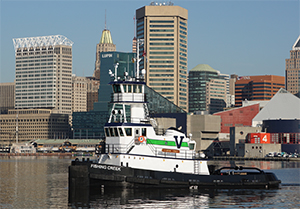In an era where more operators are using articulated tug-barge units to move oil and fuel, the model bow tugboat might seem like a throwback. Vane Brothers defies this notion, however, having built a modern fleet of versatile model bows working along the East Coast.
Within the past year, the Baltimore towing company has taken delivery of six model bow tugboats from shipyards in Maryland and Florida. It also has contracts to build at least 10 more in the coming years across two vessel classes.
Senior Port Capt. Jim Demske, who oversees Vane’s construction program, said this design was chosen out of necessity. Years ago, Vane used barges of different sizes for bunker work, terminal deliveries and coastal runs. The company needed a tugboat that could handle different jobs efficiently.
“We found model bow tugs to be the most effective solution,” Demske said recently. “Most of our modern model bow tugs can grab any barge at any time and safely tow barges astern, push barges, tow barges alongside or assist other tugs and barges.”
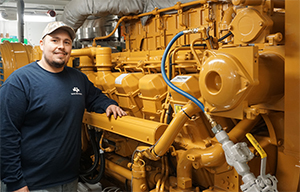 |
|
Licensed engineer Wesley West stands alongside one of two Caterpillar 3512C Tier 3 mains aboard the tug. |
Fishing Creek is the latest Sassafras-class tugboat built by Chesapeake Shipbuilding of Salisbury, Md. The yard has delivered 13 of the vessels since 2008 when the lead boat Sassafras was completed. Seven more are planned. Fishing Creek arrived at Vane’s Baltimore headquarters in late February and soon departed for Philadelphia, where it now handles bunkering barges.
“They’re fast, they’re efficient and they’re great-handling boats,” Demske said of the Sassafras class. “For that reason, they are particularly well-suited for bunkering work.”
Renowned naval architect Frank Basile designed the Sassafras class more than a decade ago to handle 30,000- and 35,000-barrel tank barges. Fishing Creek and its sister vessels feature classic model bow design: narrow beam, forward superstructure and pointed bow. Dimensions are 94 feet by 32 feet, with a 12.5-foot operating draft.
Key design features include the upper wheelhouse with a height of eye of 38 feet, accessible by Lapeyre alternating tread stairs. The vessel has tall wheelhouse windows, high ceilings in crew spaces and an engine-room floor dropped as low as possible for maximum space. These zero-discharge tugs have Simplan dripless shaft seals and oily-water separators.
Basile has retired and sold his firm to Kimia Jalili, who renamed it Entech Designs. Jalili said recent Sassafras-class tugs remained true to Basile’s design.
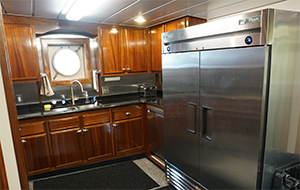 |
|
Fishing Creek has a comfortable galley with stainless steel appliances, granite countertops and mahogany cabinets. |
Vane assigned Capt. Earl Paul to Fishing Creek after his work on the 2,200-hp tugboat Endeavor. Paul found the new vessel plenty impressive during the 10-hour run across Chesapeake Bay from the shipyard to Vane’s Baltimore Harbor headquarters.
“The boat performed excellent,” Paul said during a February interview from Fishing Creek’s wheelhouse. “It is one of the smoothest tugboats I’ve ever been on.”
Propulsion on Fishing Creek comes from twin Caterpillar 3512C Tier 3 engines each producing 1,500 hp at 1,600 rpm. Those mains are linked with Twin Disc MGX-5600 reverse reduction gears at a 6:1 ratio turning 89-inch Troost-style open-wheel propellers. Operating speed is 13 knots light or 11.5 knots while towing a barge.
Twin 99-kW John Deere 4045 Tier 3 gensets provide ship service power, and a Carrier unit provides vessel heating and cooling. The bow and hull are protected by rubber fendering from M&M Bumper Service. Onboard firefighting consists of one 15-hp and one 5-hp fire pump, and a Kidde fixed CO2 fire suppression system in the engine room.
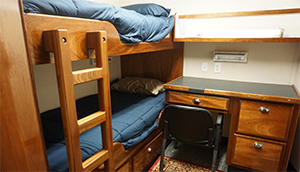 |
|
There are four cabins with accommodations for seven people. |
The spacious lower wheelhouse is equipped with a full Simrad electronics suite with solid-state radar, AIS and electronic chart display. Three LCD screens — two with touch-screen capability — hang from the ceiling, displaying navigation systems and images from two stern-mounted cameras. The console, walls and accents are made from rich mahogany.
Demske said the electronics are above and beyond what’s found on most tugs performing bunker work. “This is state of the art. This is what you see on a megayacht.”
The smaller upper wheelhouse is outfitted with similar electronics and components. Llebroc seats are installed on both levels. The vessel also has an enclosed aft-facing control station affectionately called “the doghouse.”
Like many operators, Vane Brothers has adopted a uniform wheelhouse layout across much of its roughly 50-boat fleet. This ensures consistency and also allows crew to easily transition from one tug to another, particularly when first stepping on board overnight.
Fishing Creek, like its sister vessels, is designed to tow, push and operate with barges at the hip. On deck it has a JonRie InterTech Series 500 towing winch installed at the stern spooled with 2,100 feet of 1.75-inch towing wire. The winch, coupled with a 30-hp JonRie Series 421 electric capstan, is powered by a John Deere 4045 engine.
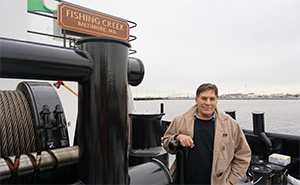 |
|
Senior Port Capt. Jim Demske oversees Vane Brothers’ new construction program. |
When towing, the wire runs over a Texas bar fitted with two circular “doughnuts” to prevent chafing. In push mode, 2.25-inch Spectra line runs off the cable, through shivs mounted at the stern and around the bow to tie off with the barge. The aft-mounted capstan and aft bitts port and starboard let the tug maneuver with a barge alongside.
“Vane’s 3,000-hp tugs married with a 30,000-barrel barge are versatile, as they can tow or push and have a capstan to allow them to also work off the hip,” said JonRie President Brandon Durar. “The smaller barges allow for them to get into more shallow places and also allow them to transit rivers pushing up and towing back down. When contracts change, the tugs can adapt.”
Vane Brothers’ crew work a two-weeks-on, two-weeks-off schedule, and the company has made comfort a priority. Fishing Creek has four bunkrooms with accommodations for seven, although the standard crew consists of five. Each room has satellite hookups and flat-screen TVs, and one double has TVs built into each bunk.
The spacious mess features a large, comfortable dining table facing a big-screen TV. The adjacent galley has stainless-steel appliances, granite countertops and mahogany cabinets. The nonslip Dex-O-Tex poured flooring and heavy wall insulation dampen vibration and engine noise. The vessel has on-demand hot water, which is both a luxury and a necessity given its relatively small 4,000-gallon water tank, Demske said.
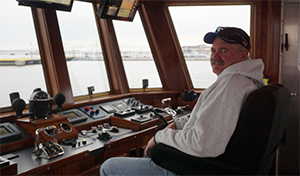 |
|
Fishing Creek Capt. Earl Paul perched in a Llebroc helm chair in the tug’s lower wheelhouse. |
Fishing Creek, like several other Vane tugs, is named for a waterway on Maryland’s Eastern Shore — a region where Vane Brothers President C. Duff Hughes has family ties. Sassafras-class vessels were the first Maryland-built tugs in 30 years, which Hughes considers a matter of great pride.
“The workmanship is impeccable, and the delivery of these hardworking 3,000-horsepower tugboats ensures that the Vane fleet remains thoroughly modern, with the latest enhancements for the safest, most productive operation,” he said.
Fishing Creek’s reign as the newest tugboat in Vane’s fleet was short-lived: The company took delivery of the fifth 4,200-hp Elizabeth Anne-class tugboat Philadelphia in April from St. Johns Ship Building in Palatka, Fla. Philadelphia marks the sixth tugboat delivery for Vane Brothers since May 2016 — a figure that includes the 3,000-hp Sassafras-class Fort McHenry that arrived in August 2016.
More vessels are in the works. Conrad Shipbuilding is constructing three ATB tugs for Vane Brothers at its Orange, Texas, yard. The first, Assateague, is expected in late summer 2017. Demske considers these ATB tugs paired with 80,000-barrel barges a natural progression for the company.
“Now that Vane is refining its fleet even more,” he said, “it’s logical that we will continue to build more articulated tug-barge combinations to serve our customers while still maintaining a strong fleet of proven hawser tugs.”

